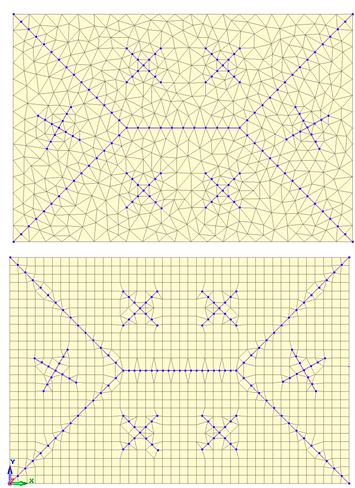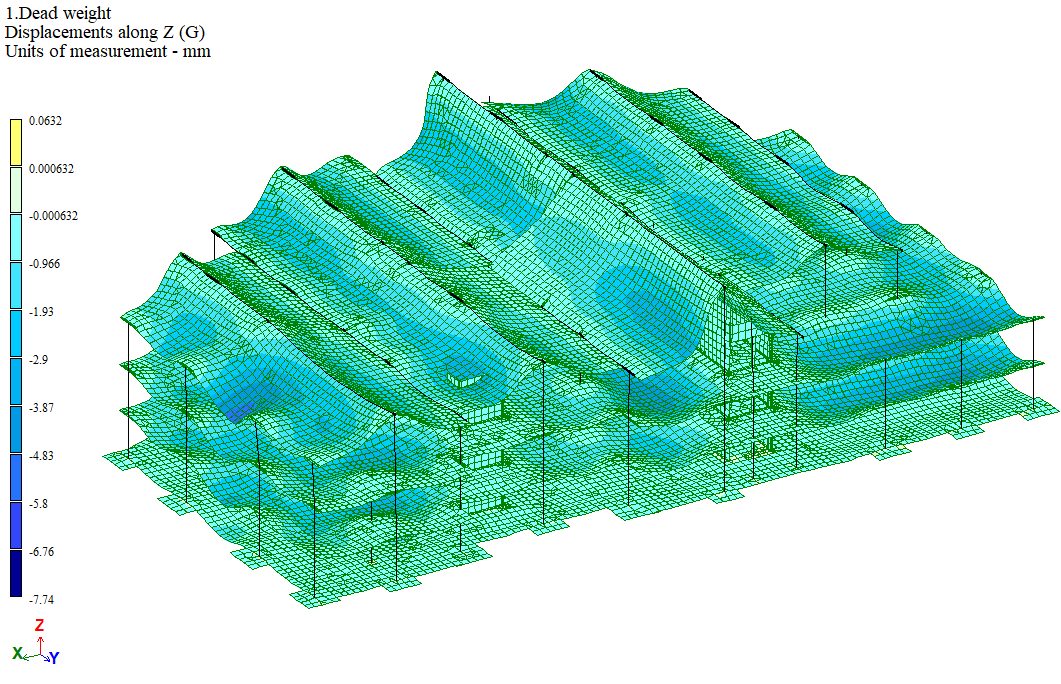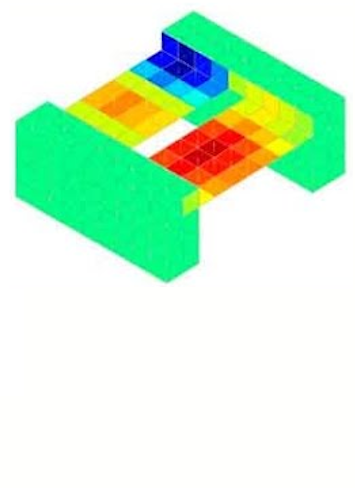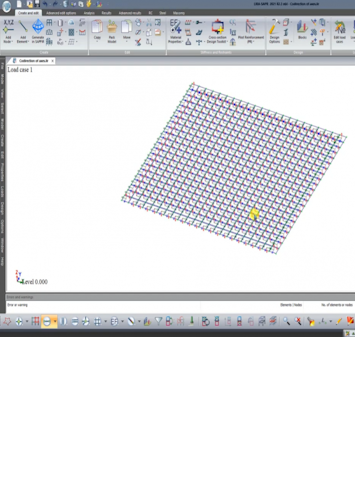List of Finite element types
In brackets you will see the model type for which this FE type is allowed.
For linear problems
FE type 1. FE of 2D truss (1,2,5)
FE type 2. FE of 2D frame (2,5)
FE type 3. FE of grillage (3,5)
FE type 4. FE of 3D truss (4,5)
FE type 7. Thin-walled bar FE with account of warping of the section (6)
FE type 10. Arbitrary 3D bar (1,2,3,4,5,6)
FE type 11. Rectangular FE of plate (3,5)
FE type 12. Triangular FE of plate (3,5)
FE type 15. Arbitrary rectangular FE of thick slab (3,5)
FE type 16. Arbitrary triangular FE of thick slab (3,5)
FE type 17. Arbitrary quadrilateral FE of thick slab (3,5)
FE type 19. Quadrilateral FE of slab (3,5)
FE type 21. Rectangular FE of 2D problem (wall-beam) (1,2,5)
FE type 22. Triangular FE of 2D problem (wall-beam) (1,2,5)
FE type 23. Arbitrary rectangular FE of 2D problem (wall-beam) (4,5)
FE type 24. Arbitrary triangular FE of 2D problem (wall-beam) (4,5)
FE type 27. Arbitrary quadrilateral FE of 2D problem (wall-beam) (4,5)
FE type 30. Quadrilateral FE of 2D problem (wall-beam) (1,2,5)
FE type 31. Parallelepiped (4,5)
FE type 32. Tetrahedron (4,5)
FE type 33. Triangular prism (4,5)
FE type 34. Arbitrary 3D (6-node) isoparametric solid (4,5)
FE type 36. Arbitrary 3D (8-node) isoparametric solid (4,5)
FE type 41. Arbitrary rectangular FE of shell (5)
FE type 42. Arbitrary triangular FE of shell (5)
FE type 44. Arbitrary quadrilateral FE of shell (5)
FE type 45. Arbitrary rectangular FE of thick shell (5)
FE type 46. Arbitrary triangular FE of thick shell (5)/p>
FE type 47. Arbitrary quadrilateral FE of thick shell (5)
FE type 51. 1-node FE of elastic spring (1,2,3,4,5)
FE type 52. FE defined with numerical stiffness matrix. It is used for the checkout of new FE types.
FE type 53. Out of contour 2-node FE of elastic foundation (3,4,5)
FE type 54. Out of contour 1-node FE of elastic foundation (3,4,5)
FE type 55. 2-node FE of elastic springs (1,2,3,4,5)
FE type 56. 1-node FE of elastic springs (1,2,3,4,5)
FE type 57. 1-node FE for piles (1,2,3,4,5)
FE type 58. Three-node FE of joint (5)
FE type 59. Four-node FE of joint (5)
FE type 60. 2-node FE of multi-layer elastic foundation (1,2,3,4,5)
FE type 62. 2-node FE damper (1,2,3,4,5)
FE type 67. Boundary 2-node FE of soil (1,2,3,4,5)
FE type 68. Boundary 3-node FE of soil (4,5)
FE type 69. Boundary 4-node FE of soil (4,5)
FE type 82. 2D triangular FE of soil body (1,2,5)
FE type 84. 2D quadrilateral FE of soil body (1,2,5)
For physically nonlinear problems
FE type 201. Physically nonlinear FE of 2D truss (1,2,5)
FE type 202. Physically nonlinear FE of 2D frame (2,5)
FE type 204. Physically nonlinear FE of 3D truss (4,5)
FE type 207. Physically nonlinear special 2-node FE of precompression (1,2,4,5)
FE type 208. Physically nonlinear special 2-node FE of pretension (1,2,4,5)
FE type 210. Physically nonlinear arbitrary 3D bar (1,2,3,4,5)
FE type 221. Physically nonlinear rectangular FE of 2D problem (wall-beam) (1,2,5)
FE type 222. Physically nonlinear triangular FE of 2D problem (wall-beam) (1,2,5)
FE type 223. Physically nonlinear arbitrary rectangular FE of 2D problem (wall-beam) (4,5)
FE type 224. Physically nonlinear arbitrary triangular FE of 2D problem (wall-beam) (4,5)
FE type 227. Physically nonlinear arbitrary quadrilateral FE of 2D problem (wall-beam) (4,5)
FE type 230. Physically nonlinear quadrilateral FE of 2D problem (wall-beam) (1,2,5)
FE type 231. Physically nonlinear parallelepiped (4,5)
FE type 232. Physically nonlinear tetrahedron (4,5)
FE type 233. Physically nonlinear triangular prism (4,5)
FE type 234. Physically nonlinear arbitrary 3D (6-node) isoparametric solid (4,5)
FE type 236. Physically nonlinear arbitrary 3D (8-node) isoparametric solid (4,5)
FE type 241. Physically nonlinear arbitrary rectangular FE of shell (5)
FE type 242. Physically nonlinear arbitrary triangular FE of shell (5)
FE type 244. Physically nonlinear arbitrary quadrilateral FE of shell (5)
FE type 245. Physically nonlinear rectangular FE of thick shell (5)
FE type 246. Physically nonlinear triangular FE of thick shell (5)
FE type 247. Physically nonlinear quadrilateral FE of thick shell (5)
FE type 251. 1-node FE of one-way spring with account of ultimate force (one-way analogue to FE type 51 with account of ultimate force) (1,2,3,4,5)
FE type 252. 2-node FE of one-way spring with account of ultimate force (1,2,3,4,5)
FE type 255. 2-node FE of elastic springs with account of ultimate forces (1,2,4,5)
FE type 256. 1-node FE of elastic springs with account of ultimate forces (similar to FE type 56 with account of ultimate force) (1,2,3,4,5)
FE type 258. Physically nonlinear three-node FE of joint (similar to FE type 58 with account of nonlinear behaviour) (5)
FE type 259. Physically nonlinear four-node FE of joint (similar to FE type 59 with account of nonlinear behaviour) (5)
FE type 261. 1-node FE of one-way elastic spring (1,2,3,4,5)
FE type 262. 2-node FE of one-way elastic spring between nodes (1,2,3,4,5)
FE type 263. 1-node one-way FE of friction (1,2,4,5)
FE type 264. 2-node one-way FE of friction between nodes (1,2,4,5)
FE type 265. 2-node FE of one-way elastic springs (similar to FE type 55 with account of one-way behaviour) (1,2,4,5)
FE type 266. 1-node FE of one-way elastic springs (similar to FE type 56 with account of one-way behaviour) (1,2,3,4,5)
FE type 271. Physically nonlinear parallelepiped (soil) (4,5)
FE type 272. Physically nonlinear tetrahedron (soil) (4,5)
FE type 273. Physically nonlinear triangular prism (soil) (4,5)
FE type 274. Physically nonlinear (6-node) isoparametric solid (soil) (arbitrary triangular prism) (4,5)
FE type 276. Physically nonlinear (8-node) isoparametric solid (soil) (arbitrary hexahedron) (4,5)
FE type 281. Physically nonlinear rectangular FE of 2D problem (soil) (1,2,5)
FE type 282. Physically nonlinear triangular FE of 2D problem (soil) (1,2,5)
FE type 284. Physically nonlinear arbitrary quadrilateral FE of 2D problem (soil) (1,2,5)
FE type 295. 2-node FE of nonlinear elastic springs (similar to FE type 255 with account of nonlinear behaviour) (1,2,4,5)
FE type 296. 1-node FE of nonlinear elastic springs (similar to FE type 256 with account of nonlinear behaviour) (1,2,3,4,5)
For geometrically nonlinear problems
FE type 308. Geometrically nonlinear special 2-node FE for simulation of pretension (1,2,4,5)
FE type 309. Geometrically nonlinear arbitrary 3D bar with large displacements (1,2,3,4,5)
FE type 310. Geometrically nonlinear arbitrary 3D bar (cable) (1,2,3,4,5)
FE type 341. Geometrically nonlinear arbitrary rectangular FE of shell (5)
FE type 342. Geometrically nonlinear arbitrary triangular FE of shell (5)
FE type 344. Geometrically nonlinear arbitrary quadrilateral FE of shell (5)
For physical and geometric nonlinearity
FE type 410. Arbitrary 3D bar with account of physical and geometrical nonlinearity (1,2,3,4,5)
FE type 441. Rectangular FE of shell with account of physical and geometrical nonlinearity (5)
FE type 442. Triangular FE of shell with account of physical and geometrical nonlinearity (5)
FE type 444. Quadrilateral FE of shell with account of physical and geometrical nonlinearity (5)
For heat conductivity
FE type 1505. Bar FE of heat conductivity (15)
FE type 1508. Triangular FE of heat conductivity (15)
FE type 1509. Quadrilateral FE of heat conductivity (15)
FE type 1512. FE of heat conductivity as tetrahedron (15)
FE type 1514. 3D 6-node FE of heat conductivity (15)
FE type 1516. 3D 8-node FE of heat conductivity (15)
FE type 1551. 1-node FE of convective heat transfer (15)
FE type 1555. 2-node FE of convective heat transfer (15)
FE type 1558. Triangular of convective heat transfer (15)
FE type 1559. Quadrilateral FE of convective heat transfer (15)







